Top 50 commonly asked Django Interview Questions and Answers
Django along with Python is one of the most in-demand skills and surely amongst some of the trickiest ones. So if you want to prepare yourself to perform the best in the upcoming Django interview, here are the top 50 commonly asked Django Interview Questions and Answers.
Q1. What is the difference between Flask and Django?
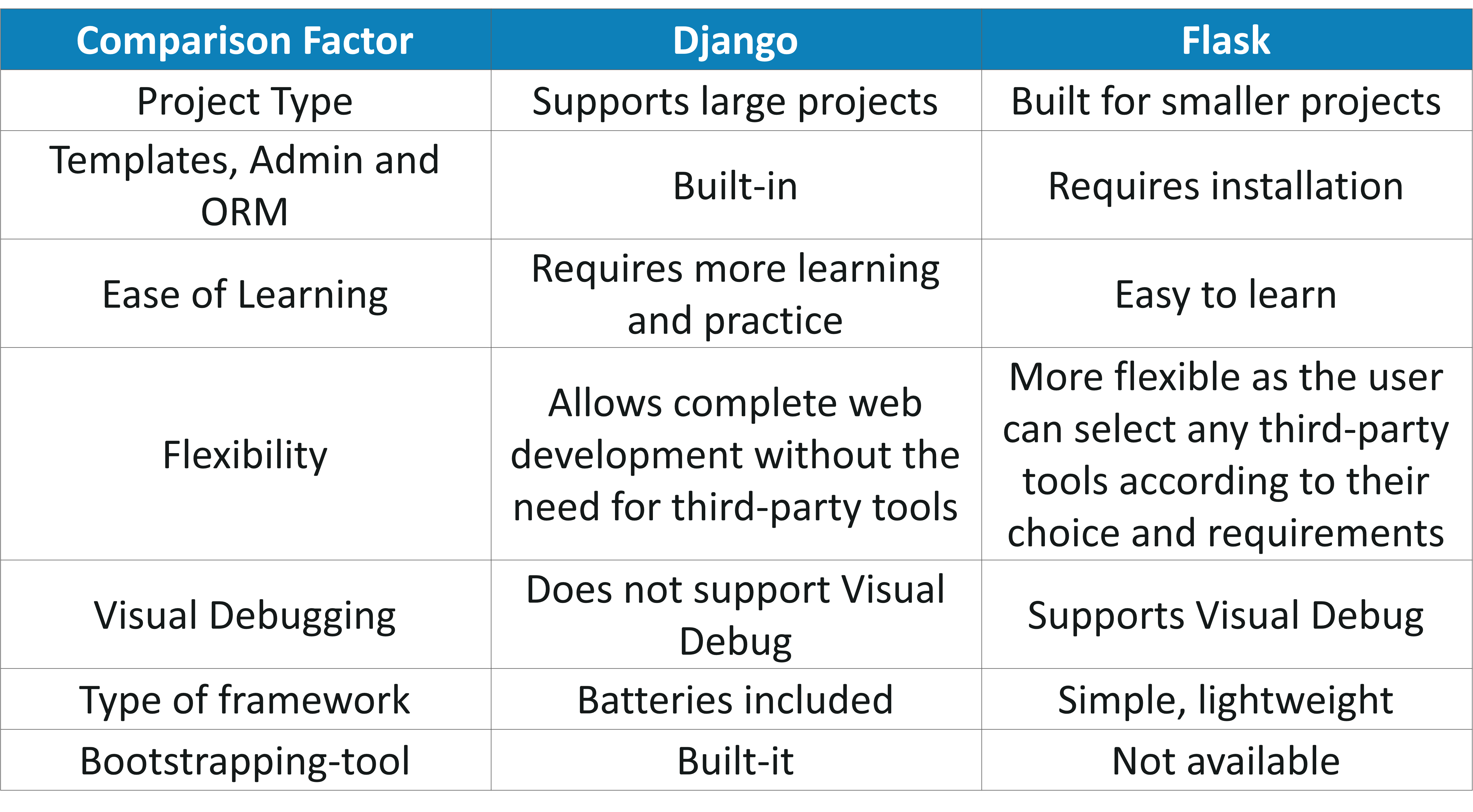
Q2. What is Django?
Django is a web development framework that was developed in a fast-paced newsroom. It is a free and open-source framework that was named after Django Reinhardt who was a jazz guitarist from the 1930s. Django is maintained by a non-profit organization called the Django Software Foundation. The main goal of Django is to enable Web Development quickly and with ease.
Q3. Name some companies that make use of Django?
Some of the companies that make use of Django are Instagram, DISCUS, Mozilla Firefox, YouTube, Pinterest, Reddit, etc.
Q4. What are the features of Django?
- SEO Optimized
- Extremely fast
- Fully loaded framework that comes along with authentications, content administrations, RSS feeds, etc
- Very secure thereby helping developers avoid common security mistakes such as cross-site request forgery (csrf), clickjacking, cross-site scripting, etc
- It is exceptionally scalable which in turn helps meet the heaviest traffic demands
- Immensely versatile which allows you to develop any kind of websites
Q5. How do you check for the version of Django installed on your system?
To check for the version of Django installed on your system, you can open the command prompt and enter the following command:
- python -m django –version
You can also try to import Django and use the get_version() method as follows:
import django
print(django.get_version())
Q6. What are the advantages of using Django?
- Django’s stack is loosely coupled with tight cohesion
- The Django apps make use of very less code
- Allows quick development of websites
- Follows the DRY or the Don’t Repeat Yourself Principle which means, one concept or a piece of data should live in just one place
- Consistent at low as well as high levels
- Behaviors are not implicitly assumed, they are rather explicitly specified
- SQL statements are not executed too many times and are optimized internally
- Can easily drop into raw SQL whenever required
- Flexibility while using URL’s
Q7. Explain Django architecture.
Django follows the MVT or Model View Template architecture which is based on the MVC or Model View Controller architecture. The main difference between these two is that Django itself takes care of the controller part.
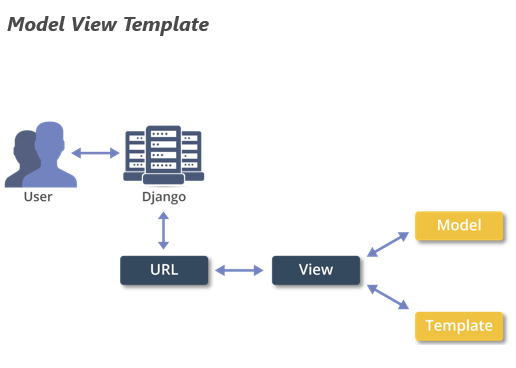
According to Django, the ‘view’ basically describes the data presented to the user. It does not deal with how the data looks but rather what the data actually is. Views are basically callback functions for the specified URL’s and these callback functions describe which data is presented.
The ‘templates’ on the other hand deal with the presentation of data, thereby, separating the content from its presentation. In Django, views delegate to the templates to present the data.
The ‘controller’ here is Django itself which sends the request to the appropriate view in accordance with the specified URL. This is why Django is referred to as MTV rather than MVC architecture.
Q8. Give a brief about ‘django-admin’.
django-admin is the command-line utility of Django for administrative tasks. Using the django-admin you can perform a number of tasks some of which are listed out in the following table:
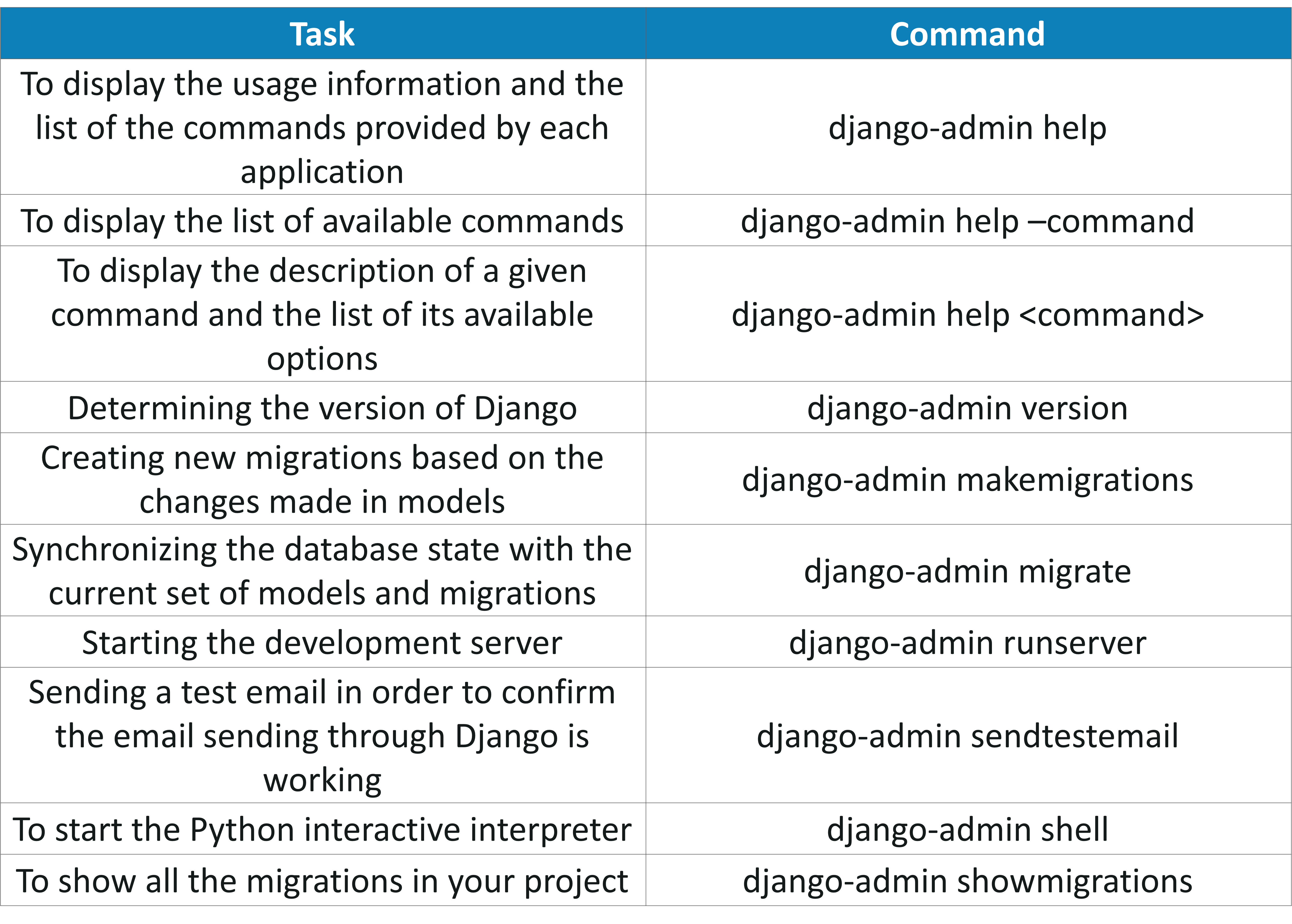
Q9. How do you connect your Django project to the database?
Django comes with a default database which is SQLite. To connect your project to this database, use the following commands:
- python manage.py migrate (migrate command looks at the INSTALLED_APPS settings and creates database tables accordingly)
- python manage.py makemigrations (tells Django you have created/ changed your models)
- python manage.py sqlmigrate (sqlmigrate takes the migration names and returns their SQL)
Q10. What are the various files that are created when you create a Django Project? Explain briefly.
When you create a project using the startproject command, the following files will be created:
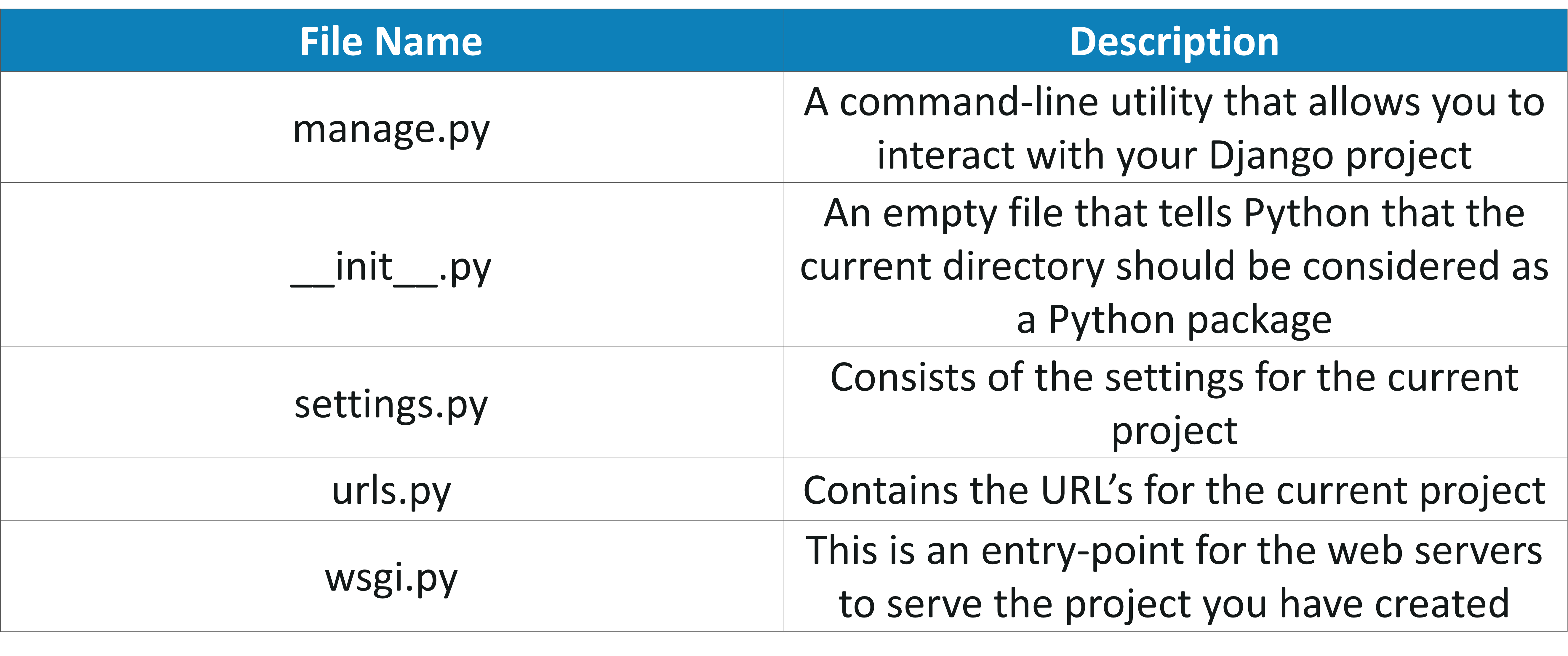
Q11. What are ‘Models’?
Models are a single and definitive source for information about your data. It consists of all the essential fields and behaviors of the data you have stored. Often, each model will map to a single specific database table.
In Django, models serve as the abstraction layer that is used for structuring and manipulating your data. Django models are a subclass of the django.db.models.Model class and the attributes in the models represent database fields.
Q12. What are ‘views’?
Django views serve the purpose of encapsulation. They encapsulate the logic liable for processing a user’s request and for returning the response back to the user. Views in Django either return an HttpResponse or raise an exception such as Http404. HttpResponse contains the objects that consist of the content that is to be rendered to the user. Views can also be used to perform tasks such as read records from the database, delegate to the templates, generate a PDF file, etc.
Q13. What are ‘templates’?
Django’s template layer renders the information to be presented to the user in a designer-friendly format. Using templates, you can generate HTML dynamically. The HTML consists of both static as well as dynamic parts of the content. You can have any number of templates depending on the requirement of your project. It is also fine to have none of them.
Django has its own template system called the Django template language (DTL). Regardless of the backend, you can also load and render templates using Django’s standard admin.
Q14. What is the difference between a Project and an App?
An app is basically a Web Application that is created to do something for example, a database of employee records. A project, on the other hand, is a collection of apps of some particular website. Therefore, a single project can consist of ‘n’ number of apps and a single app can be in multiple projects.
Q15. What are the different inheritance styles in Django?
Django has three possible inheritance styles:
Abstract base classes — Used when you want to use the parent class to hold information that you don’t want to type for each child model. Here, the parent class is never used in solitude
Multi-table inheritance — Used when you have to subclass an existing model and want each model to have its own database table
Proxy models — Used if you only want to modify the Python-level behavior of a model, without changing the ‘models’ fields in any way
Q16. What are static files?
Static files in Django are those files that serve the purpose of additional files such as the CSS, images or JavaScript files. These files are managed by django.contrib.staticfiles. These files are created within the project app directory by creating a subdirectory named as static.
Q17. What are ‘signals’?
Django consists of a signal dispatcher that helps allow decoupled applications to get notified when actions occur elsewhere in the framework. Django provides a set of built-in signals that basically allow senders to notify a set of receivers when some action is executed. Some of the signals are as follows:

Q18. Briefly explain Django Field Class.
‘Field’ is basically an abstract class that actually represents a column in the database table. The Field class, is in turn, a subclass of RegisterLookupMixin. In Django, these fields are used to create database tables (db_type()) which are used to map Python types to the database using get_prep_value() and vice versa using from_db_value() method_._ Therefore, fields are fundamental pieces in different Django APIs such as models and querysets.
Q19. How to do you create a Django project?
To create a Django project, cd into the directory where you would like to create your project and type the following command:
- django-admin startproject xyz
NOTE: Here, xyz is the name of the project. You can give any name that you desire.
Q20. What is mixin?
Mixin is a type of multiple inheritance wherein you can combine behaviors and attributes of more than one parent class. Mixins provide an excellent way to reuse code from multiple classes. For example, generic class-based views consist of a mixin called TemplateResponseMixin whose purpose is to define render_to_response() method. When this is combined with a class present in the View, the result will be a TemplateView class.
One drawback of using these mixins is that it becomes difficult to analyze what a child class is doing and which methods to override in case of its code being too scattered between multiple classes.
Q21. What are ‘sessions’?
Sessions are fully supported in Django. Using the session framework, you can easily store and retrieve arbitrary data based on the per-site-visitors. This framework basically stores data on the server-side and takes care of sending and receiving cookies. These cookies consist of a session ID but not the actual data itself unless you explicitly use a cookie-based backend.
Q22. What do you mean by context?
Context in Django is a dictionary mapping template variable name given to Python objects. This is the conventional name, but you can give any other name of your choice if you wish to do it.
Q23. When can you use iterators in Django ORM?
Iterators in Python are basically containers that consist of a countable number of elements. Any object that is an iterator implements two methods which are, the init() and the next() methods. When you are making use of iterators in Django, the best situation to do it is when you have to process results that will require a large amount of memory space. To do this, you can make use of the iterator() method which basically evaluates a QuerySet and returns the corresponding iterator over the results.
Q24. Explain the caching strategies of Django?
Caching basically means to save the output of an expensive calculation in order to avoid performing the same calculation again. Django provides a robust cache system which in turn helps you save dynamic web pages so that they don’t have to be evaluated over and over again for each request. Some of the caching strategies of Django are listed down in the following table:
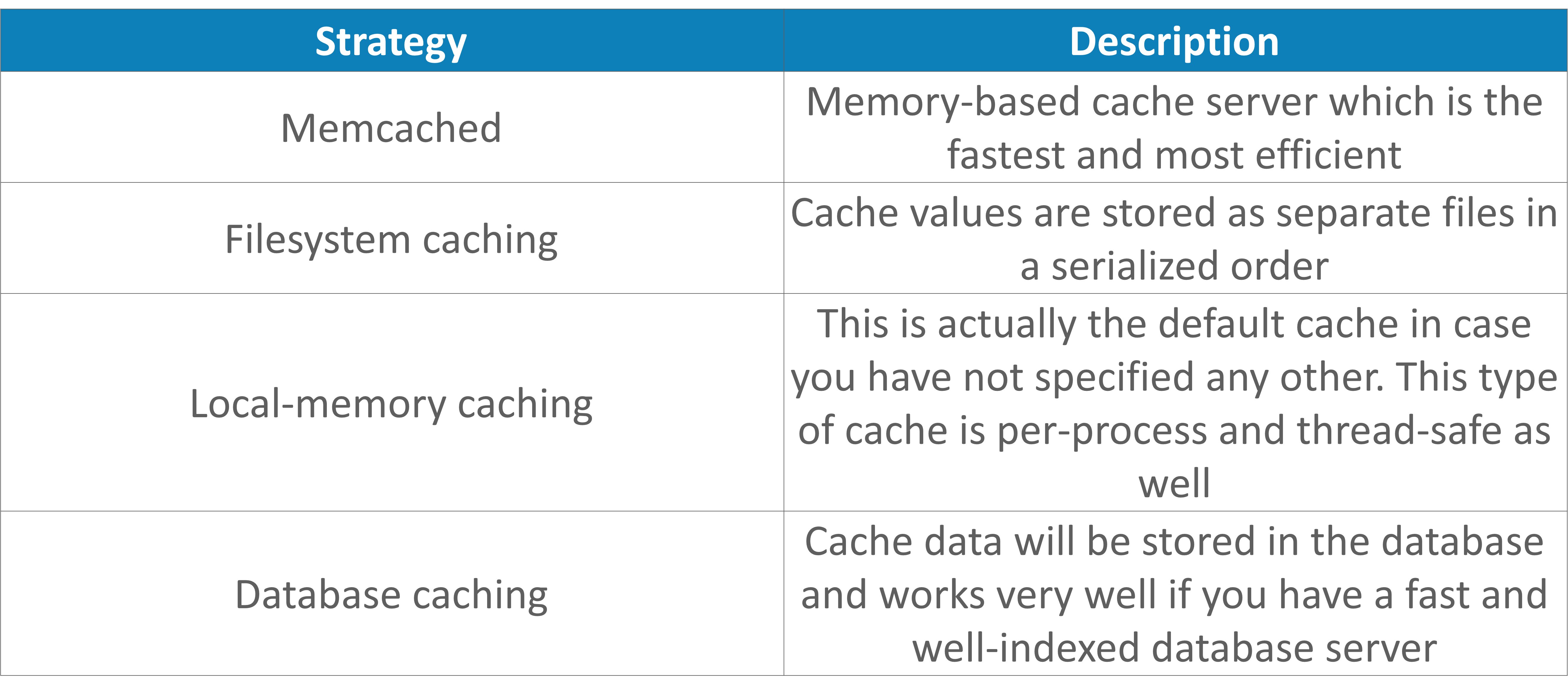
Q25. Explain the use of Middlewares in Django.
Middleware is a framework that is light and low-level plugin system for altering Django’s input and output globally. It is basically a framework of hooks into the request/ response processing of Django. Each component in middleware has some particular task.
For example, the AuthenticationMiddleware is used to associate users with requests using sessions. Django provides many other middlewares such as cache middleware to enable site-wide cache, common middleware that performs many tasks such as forbidding access to user agents, URL rewriting, etc, GZip middleware which is used to compress the content for browsers, etc.
Q26. What is the significance of manage.py file in Django?
The manage.py file is automatically generated whenever you create a project. This is basically a command-line utility that helps you to interact with your Django project in various ways. It does the same things as django-admin but along with that, it also sets the DJANGO_SETTINGS_MODULE environment variable in order to point to your project’s settings. Usually, it is better to make use of manage.py rather than the django-admin in case you are working on a single project.
Q27. Explain the use of ‘migrate’ command in Django?
In Django, migrations are used to propagate changes made to the models. The migrate command is basically used to apply or unapply migrations changes made to the models. This command basically synchronizes the current set of models and migrations with the database state. You can use this command with or without parameters. In case you do not specify any parameter, all apps will have all their migrations running.
Q28. How to view and filter items from the database?
In order to view all the items from your database, you can make use of the ‘all()’ function in your interactive shell as follows:
- XYZ.objects.all() where XYZ is some class that you have created in your models
To filter out some element from your database, you either use the get() method or the filter method as follows:
- XYZ.objects.filter(pk=1)
- XYZ.objects.get(id=1)
Q29. Explain how a request is processed in Django?
In case some user requests a page from some Django powered site, the system follows an algorithm that determines which Python code needs to be executed. Here are the steps that sum up the algorithm:
- Django first determines which root URLconf or URL configuration module is to be used
- Then, that particular Python module is loaded and then Django looks for the variable urlpatterns
- These URL patterns are then run by Django, and it stops at the first match of the requested URL
- Once that is done, the Django then imports and calls the given view
- In case none of the URLs match the requested URL, Django invokes an error-handling view
Q30. How did Django come into existence?
Django basically grew from a very practical need. World Online developers namely Adrian Holovaty and Simon Willison started using Python to develop its websites. As they went on building intensive, richly interactive sites, they began to pull out a generic Web development framework that allowed them to build Web applications more and more quickly. In summer 2005, World Online decided to open-source the resulting software, which is, Django.
Q31. How to use file-based sessions?
In order to make use of file-based sessions, you will need to set the SESSION_ENGINE setting to “django.contrib.sessions.backends.
file”.
Q32. Explain the Django URLs in brief?
Django allows you to design your own URLs however you like. The aim is to maintain a clean URL scheme without any framework limitations. In order to create URLs for your app, you will need to create a Python module informally called the URLconf or URL configuration which is pure Python code and is also a mapping between the URL path expressions to the Python methods.
The length of this mapping can be as long or short as required and can also reference other mappings. When processing a request, the requested URL is matched with the URLs present in the urls.py file and the corresponding view is retrieved. For more details about this, you can refer to the answer to Q29.
Q33. Give the exception classes present in Django.
Django uses its own exceptions as well as those present in Python. Django core exceptions are present in django.core.exceptions class some of which are mentioned in the table below:
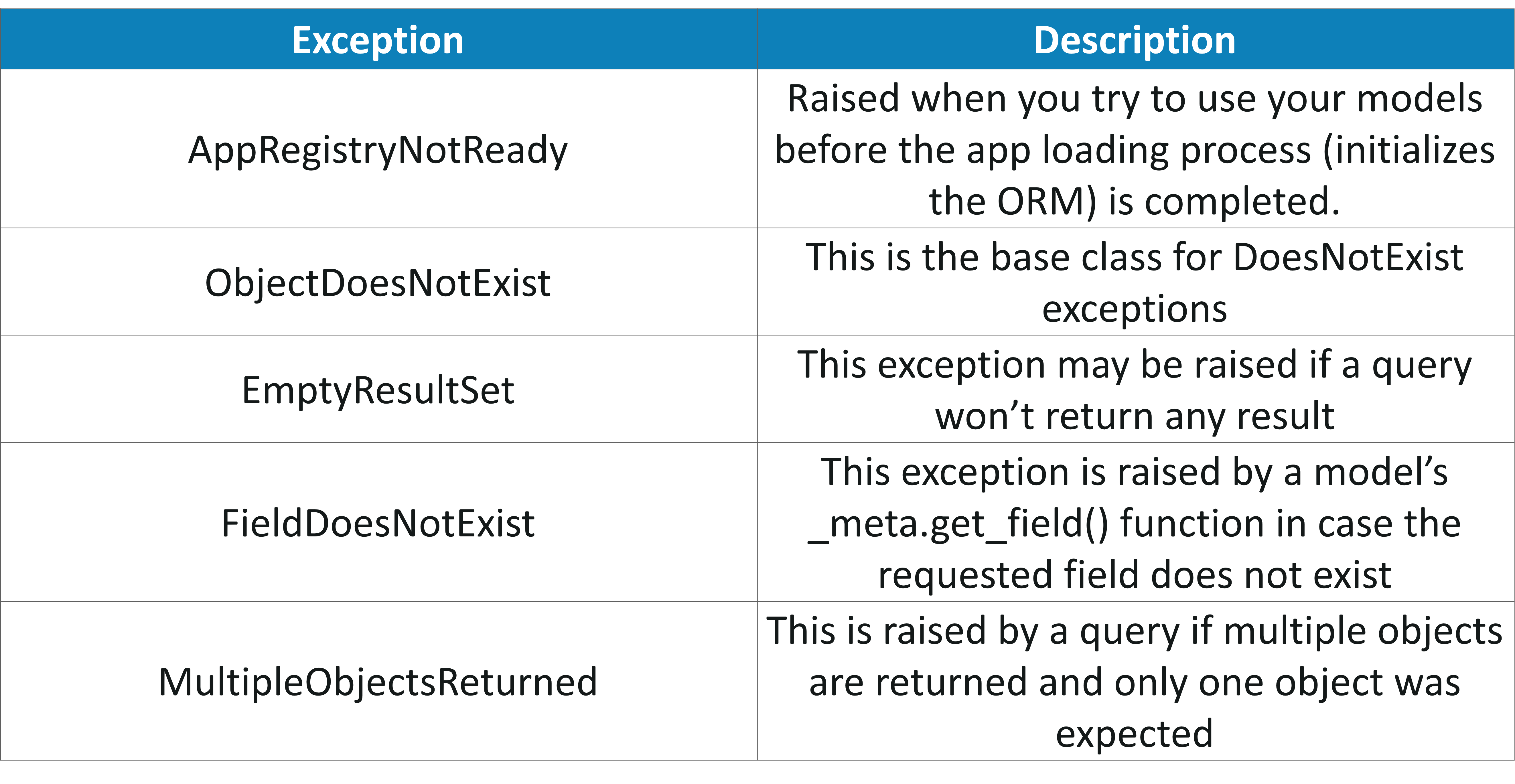
Q34. Is Django stable?
Yes, Django is quite stable. Many companies like Instagram, Discus, Pinterest, and Mozilla have been using Django for a duration of many years now. Not just this, Websites that are built using Django have weathered traffic spikes of over 50 thousand hits per second.
Q35. Does the Django framework scale?
Yes. Hardware is much cheaper when compared to the development time and this is why Django is designed to make full use of any amount of hardware that you can provide it. Django makes use of a “shared-nothing” architecture meaning you can add hardware at any level i.e database servers, caching servers or Web/ application servers.
Q36. Is Django a CMS?
Django is not a CMS (content-management-system) . It is just a Web framework, a tool that allows you to build websites.
Q37. What Python version should be used with Django?
The following table gives you the details of the versions of Python that you can use for Django:

Python 3 is actually the most recommended because it is fast, has more features and is better supported. In the case of Python 2.7, Django 1.1 can be used along with it but only till the year 2020.
Q38. Does Django support NoSQL?
NoSQL basically stands for “not only SQL”. This is considered as an alternative to the traditional RDBMS or the relational Databases. Officially, Django does not support NoSQL databases. However, there are third-party projects, such as Django non-rel, that allow NoSQL functionality in Django. Currently, you can use MongoDB and Google App Engine.
Q39. How can you customize the functionality of the Django admin interface?
There are a number of ways to do this. You can piggyback on top of an add/ change form that is automatically generated by Django, you can add JavaScript modules using the js parameter. This parameter is basically a list of URLs that point to the JavaScript modules that are to be included in your project within a
#Django #python #interview-question
